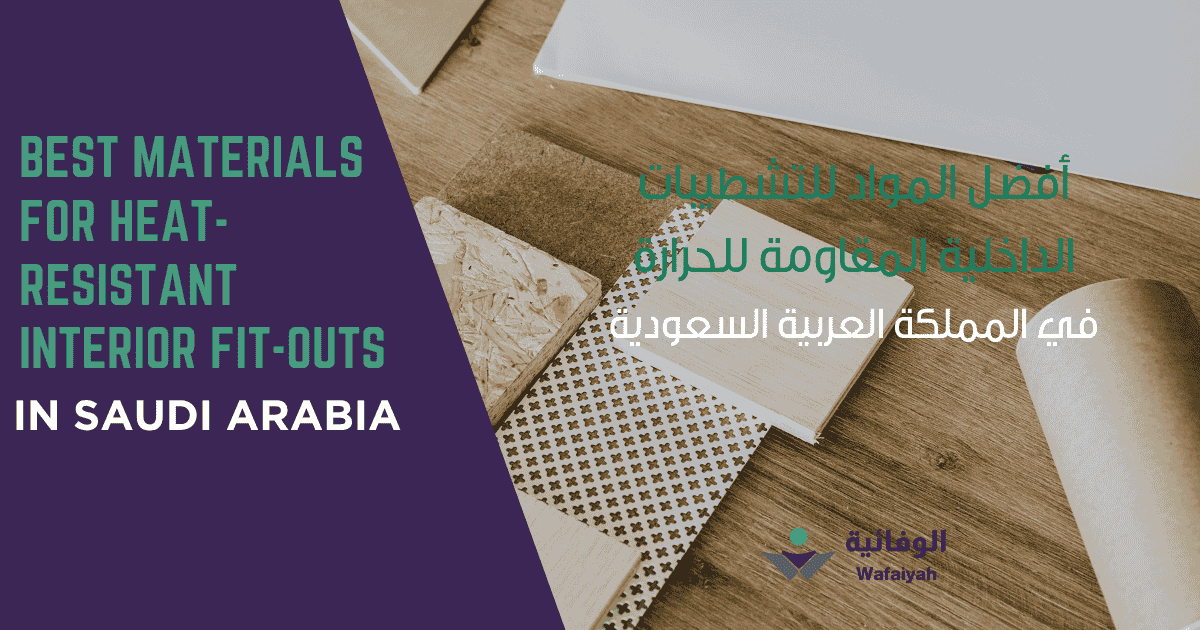Saudi Arabia’s climate is known for its intense heat, especially during the long summer months. These extreme temperatures can affect both comfort and the lifespan of interiors in homes, commercial buildings, and hospitality spaces. Choosing the right materials is not just a design; it’s a necessity. Wafaiyah understands how important it is to create interiors that stay cool, last longer, and look beautiful despite the heat. This article offers a clear guide to the best materials for hot climates, focusing on durability, performance, and style to help you make smart, heat-resistant choices for any space.
When planning interior fit-outs, choosing the right materials is essential. Heat-resistant materials not only improve safety but also extend the life of your design. Options like fire-rated gypsum boards, ceramic tiles, stainless steel, and treated hardwood are excellent choices. These materials perform well under pressure and maintain their look over time. Glass with thermal coatings can also help manage heat without compromising style. A wise material choice not only ensures safety but also adds long-term value to the project. Always work with trusted suppliers and certified products to meet fire safety standards and build a reliable, lasting interior.
Gypsum Board with Fire-Resistant Core
This material looks attractive for ceilings and partition walls since they are effective in fire resistance. They contribute to reducing the transmission of flames to make buildings safe, even during fire mishaps. These boards are easy to install, cost-effective, and have a smooth finish that does wonders in growing to be painted and decorated. Among the highlighted benefits of the gypsum boards is that they are fire-resistant and thus ensure that a fire is entirely under control. They are economical as compared to most of the other fire-resistant materials. Their use has been widespread for large, complex projects. The lightweight nature makes them easy to handle and to install, saving labour time and cost.
Fire-Rated Glass Panels
Fire-rated glass is safe and beautiful. It is fireproof and allows natural light to enter. This is a perfect finishing material for doors, windows, or all kinds of open spaces without compromising fire safety. One of the significant advantages of this material is that, due to its transparency, it can be used to allow natural daylight to light interiors. This eliminates the requirement of artificial lighting and makes things look less congested. When under fire, the glass is designed to be able to withstand the heat without shattering. It is popularly used in modern architecture due to its modern sleek looks, at the same time meeting the safety requirements.
Calcium Silicate Boards
Calcium silicate boards are popular for being strong and stable during exposure to excessive heat. Such boards are warp-resistant and crack-resistant. Their use has been shared for commercial interiors to cover walls, ceilings and ducts. They are moisture resistant and light in weight, which also makes them reliable in the long run. The main advantage of this material is its high resistance to heat. They do not break or deform at high temperatures. They are also waterproof, which makes them popular in damp areas. The boards are light, so they are easy to manage and can be installed easily as compared to heavier boards. Also, they are resistant to impact and can be used in high-traffic areas.
Mineral Wool Insulation
Mineral wool insulation is also valued because it is soundproof and fire-resistant. Being an environmentally friendly substance, this material is made up of either natural rock or slag and further contributes to temperature control within buildings. This is usually attached to the wall or ceiling to improve the energy efficiency and safety in terms of fire. Mineral wool has been known to withstand extremely high temperatures and hence is a perfect fire barrier. It also has an outstanding sound insulation and reduces the transmission of sound to give better comfort within the building. Mineral wool is an environmentally friendly solution since it is made of natural and recycled materials. The thermal insulation helps it to keep the indoor conditions stable and consume less energy and expenditure on heating or cooling.
Ceramic Tiles and Cladding
Ceramic tiles and cladding are heat-proof and washable, which makes them suitable for use on the floor, kitchen wall, and countertops. They are available in a variety of styles and colours, which makes them a good combination of functionality and stylishness. They are popular in places, especially those with direct contact with heat or prone to fires.
Ceramic tiles are very unresponsive to heat. They come in very strong materials, and do not scratch, stain, or wear, thus increasing their lifespan. The different colours, patterns and finishes give them huge design potential. Ceramic tiles are also very easy to clean and maintain since they have non-porous surfaces.
Criteria for Choosing the Best Heat-Resistant Materials
Handles Heat Well
Select those materials which resist high temperatures and prevent high heat exposure. This assists in keeping things cool and saves energy. Better insulation will be more comfortable and more effective. It is essential for homes and businesses that require the ability to change the heat to save money and for safety reasons as well.
Stays Strong in Sunlight
Select materials which do not discolour or crack in the sunshine. UV-resistant materials will never fade, crack or weaken over time. This is important in anything which can be used in open areas. It extends the life of the material and makes it attractive, hence you need not replace it frequently.
Doesn’t Soak Up Heat
Select materials which do not absorb a lot of heat. This will cause surfaces to be colder and safer to touch. It can also perform in places where it is sunny or hot. The low heat absorption also saves the components and lets the buildings or products stay more convenient, and consumes less energy.
Keeps Its Shape in Hot or Cold
Select the materials which do not change in size when the temperature changes. It would not warp or crack if the material remains the same. That is why it is well fitting and will work long enough. It comes in handy in areas that experience a high change in weather or temperature.
Long-Lasting and Easy to Clean
Make sure to select materials which are durable and do not require much maintenance. Durable materials are strong enough even when they are used frequently or during foul weather. They are time and money-saving as well as easy to clean. This is excellent where there are areas which have a lot of traffic.
Safe Around Fire
Select materials that are not easily combustible and use the fire safety code. Non-combustible materials prevent the propagation of smoke and flames. This is very common anywhere, such as buildings, industries, or any other places where there is a risk of fire.
Practical Installation and Maintenance Tips for Heat-Resistant Materials
Heat-resistant panels, insulation, or finish surfaces should be clean and dry before placing the installation. Apply good tools and follow the instructions of the manufacturers to ensure a secure fit. Avoid missing information in a way that can mess up the material. Leave some spaces where necessary to allow expansion and contraction. In hot climates, a frequent schedule of maintenance should be carried out to increase the life of the heat-resistant material. Inspect the panels, coatings and insulation at a minimum of 2 times annually and look for signs of wear, cracks or breakage. When noticed early, this saves on expensive repairs, and the thermal performance is maintained.
The ways of cleaning are different according to the material. In the case of stone and metals, apply mild and non-abrasive cleaning agents and soft bristles so as not to hurt the surface. They should wipe the coatings using gentle solutions, and gentle clothes and fabrics should be treated according to the material condition. Poor installation, maintenance, and careless cleaning products also feature on this list of mistakes. Avoid them to have your materials remain protective and have longer durations towards heat stress.
Conclusion
Choosing the right materials for construction in Saudi Arabia’s climate is crucial. Wafaiyah understands how heat, sand, and humidity affect long-term performance. The right materials ensure comfort, reduce energy use, and lower maintenance costs. Always consult trusted local suppliers and certified contractors for the best results. In the end, prioritize performance over cost to build spaces that are both sustainable and comfortable for years to come.
Frequently Asked Questions
What is the most heat-resistant material for interior walls in Saudi Arabia?
Gypsum boards with integrated thermal insulation and AAC blocks are among the top choices due to their fire resistance and heat-blocking capabilities.
Is it better to use stone or tile flooring in hot climates?
Both are good, but stone (like granite or slate) offers superior thermal mass and stays cool underfoot, making it ideal for Saudi homes.
Can glass be heat-resistant in interiors?
Yes, using Low-E or double-glazed glass helps control solar heat gain while maintaining visibility and aesthetics.
Are heat-reflective paints effective?
They can reduce surface temperatures significantly, especially when applied to ceilings and walls exposed to direct sunlight.

